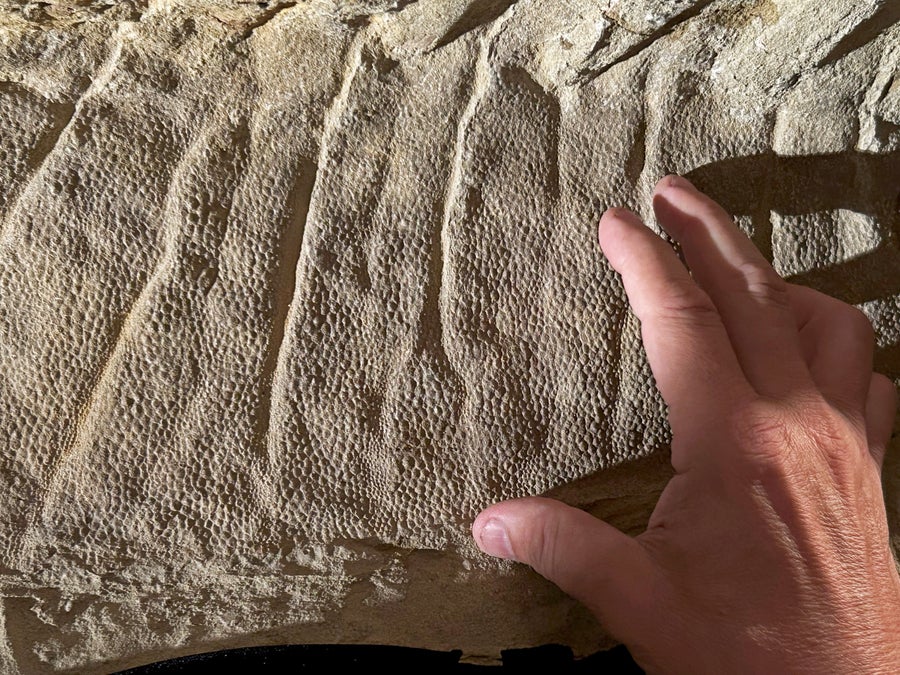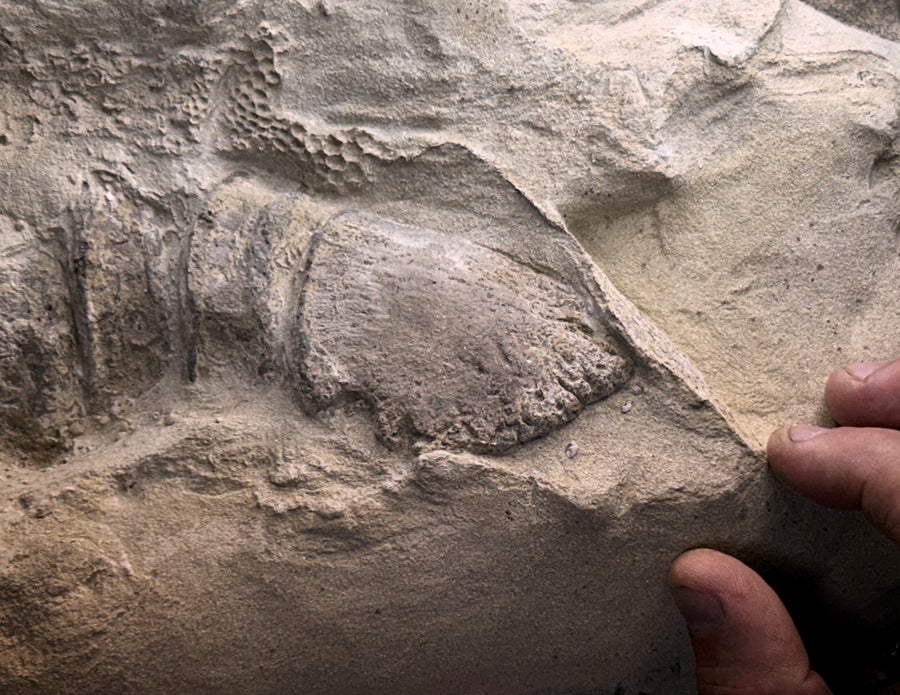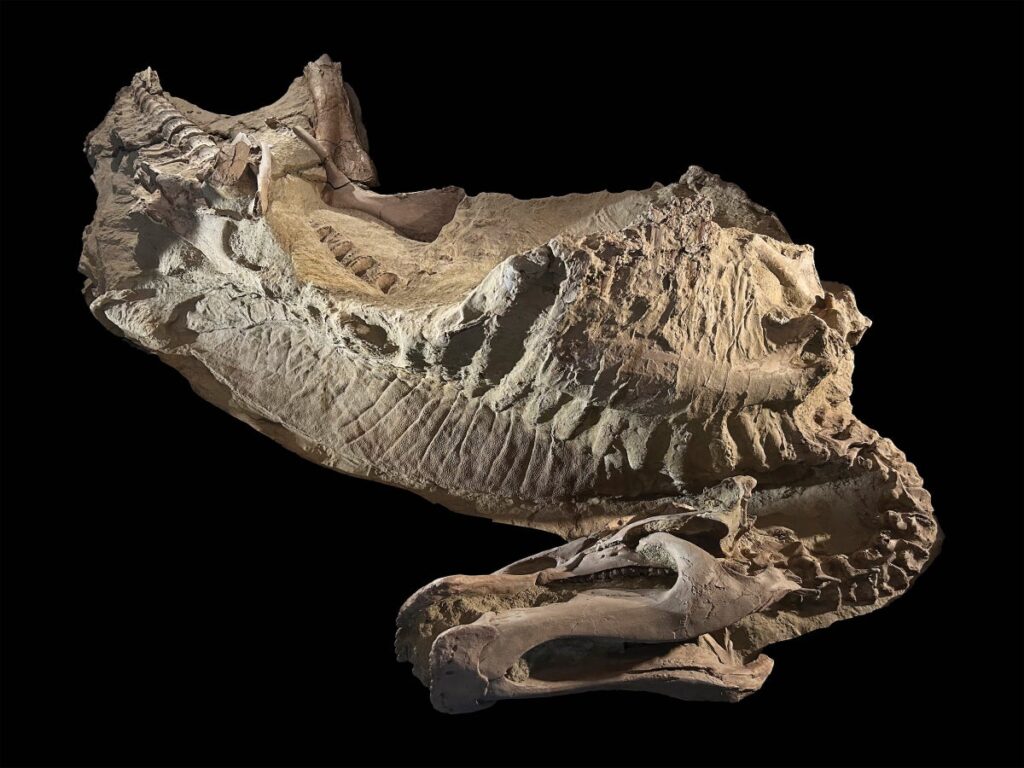October 23, 2025
3 min read
Fossilized Skin on Dinosaur ‘Mummies’ Isn’t Skin at All
Wyoming’s “dinosaur mummies,” once thought to preserve fossilized flesh, are actually detailed clay molds formed by microbes as the creatures decayed
Mummy of the juvenile duck-billed dinosaur Edmontosaurus annectens preserved as a dried carcass resting on its ribcage some 66 million years ago. Large areas of scaly, wrinkled skin and a tall fleshy crest over its back were preserved as in a thin layer of clay over its fossilized skeleton.
More than a century ago prolific fossil collector Charles Sternberg discovered the skeleton of a duck-billed Edmontosaurus dinosaur in the sandstone rocks of the Lance Formation in eastern Wyoming. The remains were covered in fossilized flesh and skin, making it the first “dinosaur mummy” ever found. Two years later Sternberg would find another one just a few kilometers away.
New research reveals, however, that the skin found on newly discovered duck-billed dinosaur “mummies” from the same area—and maybe Sternberg’s as well—aren’t fossilized flesh at all but clay molds welded by microbes as the creatures decayed.
“That’s going to come as a shocker to a lot of people,” says University of Chicago paleontologist Paul Sereno, lead author of the new study, published in Science. This clay molding process was known to preserve the form of soft animals in oxygen-poor areas, such as the muds at the bottom of lagoons and deep-sea trenches, Sereno says. But “no one imagined it could work its magic on a dinosaur buried suddenly by sand in a flooded river,” an environment that is fairly oxygen-rich.
On supporting science journalism
If you’re enjoying this article, consider supporting our award-winning journalism by subscribing. By purchasing a subscription you are helping to ensure the future of impactful stories about the discoveries and ideas shaping our world today.

The scaly skin of a crest over the back of the juvenile duck-billed dinosaur Edmontosaurus annectens, nicknamed “Ed Jr.” The juvenile duckbill, estimated to be about two years old at the time it died, is the only juvenile dinosaur mummy ever discovered.
When “mummified” in this way, all of an animal’s outside soft tissues become films of clay less than 1 millimeter thick. Sereno proposes that the creatures’ carcasses were first desiccated in a drought before suddenly being engulfed by sediment—likely brought on by a flood. A layer of bacteria latched onto the wet, porous surface to form a biofilm, which attracted surrounding clay. Then, weeks after they were buried, the soft parts of the carcasses decayed and were washed away by groundwater, leaving the clay mask to forever preserve the forms of what lay just beneath, Sereno says.
“The sort of basic [fossilization] question of ‘How did this thing fossilize in the first place?’ hasn’t received as much attention in the past,” says Stephanie Drumheller, a paleontologist at the University of Tennessee, Knoxville, who was not involved in the study but is mentioned in its acknowledgments section. “I think this was a really great deep dive into this one area where we do see several specimens.”

Three horny spikes are preserved on atop of the tail of a mummy of an adult duck-billed dinosaur Edmontosaurus annectens nicknamed ‘Ed Sr.”.
Sereno and other researchers have managed to uncover many more mummies near Sternberg’s original Wyoming site. These have included a Triceratops horridus and a Tyrannosaurus rex, along with two more E. annectens that were described for the first time in the new study. All are within a 10-kilometer diameter of one another in an area Sereno calls the “mummy zone.”
One of these E. annectens was two years old when it died and the other five to eight years old—making them a “late juvenile” and “early adult” that the researchers named “Ed, Jr.” and “Ed, Sr.,” respectively. Ed, Jr., the “late juvenile,” is the first adolescent dinosaur mummy ever found and the first large dinosaur with a fully preserved fleshy outline of its trunk. Meanwhile Ed, Sr., the “early adult,” is the first dinosaur of its kind to have been found with a full set of spikes running along its tail, and it has the earliest known hooves of any four-footed animal.

The hoof, preserved in section as a very thin clay layer, caps the end toe bone in the foot of an adult mummy of the adult duck-billed dinosaur Edmontosaurus annectens.
The researchers used a series of methods involving x-rays, CT scans, and microscopic and chemical analyses to ensure that the fleshy parts were indeed just a clay molding. This process is painstaking, and the clay on many previous specimens has been inadvertently damaged or removed during preparation.
“They were coming at this question from a lot of different angles,” Drumheller says, “to figure out what the history of this fossil was, how this thing became a fossil in the first place—and then tying that in to the unusual conditions that seem to have been around in this environment where they have found so many mummy fossils.”
“The question now before us,” Sereno says, “is whether this clay mask preservation process applies to the other dinosaur mummies and skin renderings that have been found at many other sites around the world.”
It’s Time to Stand Up for Science
If you enjoyed this article, I’d like to ask for your support. Scientific American has served as an advocate for science and industry for 180 years, and right now may be the most critical moment in that two-century history.
I’ve been a Scientific American subscriber since I was 12 years old, and it helped shape the way I look at the world. SciAm always educates and delights me, and inspires a sense of awe for our vast, beautiful universe. I hope it does that for you, too.
If you subscribe to Scientific American, you help ensure that our coverage is centered on meaningful research and discovery; that we have the resources to report on the decisions that threaten labs across the U.S.; and that we support both budding and working scientists at a time when the value of science itself too often goes unrecognized.
In return, you get essential news, captivating podcasts, brilliant infographics, can’t-miss newsletters, must-watch videos, challenging games, and the science world’s best writing and reporting. You can even gift someone a subscription.
There has never been a more important time for us to stand up and show why science matters. I hope you’ll support us in that mission.

